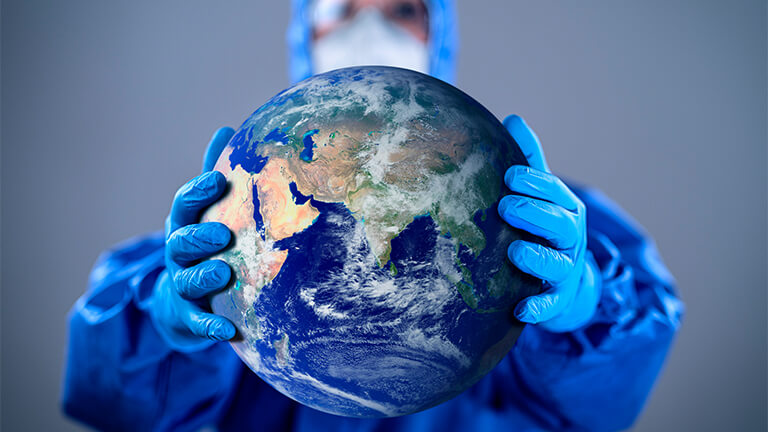Throughout the history of humankind, diseases have played a significant role, often shaping civilizations and altering the course of events. Some of these diseases, from malaria to COVID-19, have come to define our relationship with the microbial world.
These diseases can be classified differently based on their prevalence, impact, and spread. Two key terms often used in this classification are “endemic” and “pandemic”.
It is critical to understand the difference between endemic and pandemic diseases to grasp the fundamentals of epidemiology – the study of how diseases spread. The distinction also provides us, the general public, with a clearer idea of the potential threats we face and how we can protect ourselves and our communities.
Meaning of Endemic

The term “endemic” derives from the Greek words “en”, meaning “in”, and “dēmos”, meaning “people”. In epidemiology, an endemic disease is one that is consistently present in a specific geographical location or population.
Endemic diseases may have low or high prevalence, but they have a steady state of incidence, meaning new cases occur at a relatively constant rate. Some diseases that are common to specific regions include malaria in sub-Saharan Africa, dengue fever in tropical areas, and monkeypox, which has similarities to COVID-19 and can be found in central and western Africa.
These diseases persist in these areas due to a combination of factors like favorable climate for the disease-causing agents, high population density, and the lack of effective disease control measures.
Characteristics
Endemic diseases generally have a stable number of cases over time, indicating a balance between new infections and those recovering or dying. These diseases are often tied to specific areas due to the presence of environmental factors that favor the pathogen’s survival and reproduction.
Moreover, population behaviors, immunity levels, and public health practices can contribute to a disease’s endemicity.
Meaning of Pandemic

A pandemic, on the other hand, comes from the Greek words “pan”, meaning “all”, and “dēmos”, meaning “people”. It refers to an epidemic (a sudden increase in the number of cases of a disease) that has spread over several countries or continents, affecting a large number of people.
The key features of a pandemic are its geographic scale and the high incidence of disease. Historically, pandemics have had profound impacts on society. The Spanish Flu of 1918-1919 infected about a third of the world’s population and caused an estimated 20 to 50 million deaths.
More recently, the HIV/AIDS pandemic, which began in the late 20th century, has claimed over 32 million lives worldwide. The ongoing COVID-19 pandemic, first identified in 2019, has led to millions of deaths globally, demonstrating how pandemics can disrupt modern societies.
Key Features
Unlike endemic diseases, pandemics are characterized by their rapid spread and high impact. They are often caused by a new strain of a virus to which most people have little to no immunity.
The scale and severity of a pandemic can be influenced by various factors, including global travel, public health infrastructure, and how swiftly and effectively authorities respond.
Endemic’s Localized Impact
Endemic diseases primarily affect the population within a confined geographical area. Their impact is often chronic, creating a steady strain on public health systems. In communities where diseases like malaria are endemic, for instance, considerable resources are devoted to managing and treating cases, reducing the capacity to tackle other health issues.
Pandemic’s Global Impact

Pandemics, in contrast, have a global impact. They have the capacity to touch virtually everyone, either directly through infection or indirectly through the social and economic disruptions they cause.
The COVID-19 pandemic, for instance, not only caused severe health crises in many countries but also led to global economic downturns, travel restrictions, and shifts in daily life, such as remote work and online education.
Therefore, while endemic diseases represent a continuous but localized health issue, pandemics pose an immediate and global threat. Understanding this distinction can help us appreciate the scope and scale of different health crises, informing our responses to them.
Factors Contributing to Endemics
Role of Geography and Climate
Geographical factors such as terrain, climate, and the presence of certain types of fauna (like mosquitoes in the case of malaria) can create an environment conducive to the survival and spread of specific pathogens, contributing to a disease’s endemicity. These conditions can be tough to alter, hence the challenge of eradicating endemic diseases.
Human Population Density and Behavior
Human factors, like population density and behavior, also play a role. High population density can facilitate disease transmission, while certain cultural or social practices can increase exposure to disease vectors. For example, the practice of storing water in open containers can create breeding grounds for mosquitoes, contributing to the spread of dengue fever.
Disease Control Measures
The effectiveness of disease control measures greatly influences the endemicity of a disease. Challenges such as limited resources, lack of access to healthcare, and insufficient vaccination coverage can all contribute to a disease becoming endemic.
Factors Contributing to Pandemics

Origin and Transmission of Diseases
Pandemics usually begin with a novel pathogen to which the global population has little to no immunity. The pathogen can originate from a variety of sources, often involving zoonotic transmission – where a disease jumps from animals to humans.
The transmission of the disease from person to person can then lead to rapid global spread. In today’s interconnected world, global travel and trade facilitate the quick spread of diseases.
A person carrying a pathogen can travel thousands of miles before symptoms even appear, unwittingly spreading the disease across borders. Once a pandemic has started, containment becomes a formidable challenge.
Efficient and coordinated international responses are required, which can be complicated by political, economic, and logistical issues.
Duration and Persistence
Endemic diseases, by definition, persist in communities over long periods, often indefinitely. They become part of the “normal” health landscape of a region. For instance, malaria has been endemic in parts of Africa for thousands of years.
Pandemics typically have a more limited duration, characterized by an outbreak phase, a peak, and eventually a resolution. However, the timeline can range from months to years, depending on various factors including the disease’s characteristics and the effectiveness of control measures.
Therefore, while endemic diseases can be thought of as a marathon – a steady, prolonged challenge – pandemics are more like a sprint, albeit a strenuous and potentially devastating one. After a pandemic resolves, the disease might disappear, become seasonal, or in some cases, become endemic.
Public Health Response

Managing endemic diseases often requires sustained local efforts. This can involve continuous surveillance, routine vaccinations, and ongoing public health education. The success of these efforts is often dependent on local infrastructure and resources.
In contrast, pandemics demand immediate, large-scale, and coordinated international responses. The World Health Organization (WHO) typically plays a leading role, coordinating efforts to monitor the spread, advising on protective measures, and aiding in the development and distribution of treatments or vaccines.
In both cases, having preparedness and response plans is crucial. These plans, which outline strategies for surveillance, containment, treatment, and communication, can greatly enhance the speed and effectiveness of the public health response.
Impact on Healthcare Systems

Endemic diseases place a steady strain on healthcare systems, particularly in resource-poor settings. This constant burden can limit the ability of these systems to respond to other health issues, contributing to broader health disparities.
Pandemics, on the other hand, can overwhelm healthcare systems with a sudden surge of cases. This can lead to resource shortages, from hospital beds to medical staff, disrupting care for all patients, not just those with the pandemic disease.
Thus, the challenge for healthcare systems is two-fold: managing the steady pressure from endemic diseases without neglecting routine care, and scaling up capacity swiftly and effectively during pandemics to handle the sudden increase in patients.
Social and Economic Consequences
Endemic diseases can have profound social and economic impacts on the communities they afflict. They can reduce overall productivity and economic growth, exacerbate poverty, and contribute to social inequality. Also, they often lead to long-term health complications that can strain individuals and families.
In contrast, pandemics can lead to dramatic global social and economic disruptions. Businesses close, travel grinds to a halt, stock markets plunge, and unemployment rates soar.
Moreover, fear and uncertainty during a pandemic can have significant mental health impacts. History shows us that both endemic diseases and pandemics can have profound and lasting impacts and that we must strive to mitigate these through proactive public health measures and social and economic support systems.
Mitigation and Prevention Strategies
Controlling endemic diseases often involves targeted measures like vaccination programs, vector control strategies (e.g., mosquito nets for malaria), and improvements in sanitation and hygiene. It’s crucial to adapt these strategies to local conditions and cultural practices.
For pandemics, prevention and containment strategies often involve travel restrictions, quarantines, social distancing, and the rapid development and distribution of vaccines. The aim is to slow the spread of the disease, reducing the peak burden on healthcare systems – a concept known as “flattening the curve”.
Vaccine Development and Distribution
Vaccine development and distribution play a crucial role in controlling both endemic diseases and pandemics. Vaccines can provide population-wide protection, drastically reducing the number of susceptible individuals and thereby the overall spread of the disease.
Importance of Accurate Data in Both Cases

In the context of both endemic diseases and pandemics, accurate and timely information is vital. It guides public health responses, informs policy decisions, and helps the public understand the risks and the measures they need to take.
However, communicating risk and uncertainty can be challenging. Messages need to be clear, consistent, and transparent to build public trust. Furthermore, they need to reach diverse populations, taking into account varying levels of health literacy and language proficiency.
In this digital age, both media and health authorities play a critical role in disseminating information and combating misinformation. This task is especially crucial (and challenging) during a pandemic when fear and uncertainty can fuel the spread of rumors and false information.
FAQs:
How does a pandemic become endemic?
A pandemic can become endemic when the disease is still around but its spread becomes more predictable, stable, and manageable.
What is an example of a disease that is both endemic in some regions and pandemic in others?
HIV/AIDS is an example of a disease that is endemic in some regions (like sub-Saharan Africa) and has reached pandemic levels globally.
How does herd immunity relate to endemic and pandemic diseases?
Herd immunity refers to when a large portion of a community becomes immune to a disease, making the spread of the disease from person to person unlikely. As a result, the whole community becomes protected, not just those who are immune.
In the context of endemic diseases, herd immunity can help keep the disease at manageable levels. For pandemic diseases, achieving herd immunity (through vaccination or previous infection) can help end the pandemic.
What is the difference in terms of mortality rate?
The mortality rate of a pandemic can be high initially due to the rapid spread of the disease and the lack of immunity in the population. As for an endemic disease, the mortality rate can be stable and often lower, as the population may have some level of immunity or effective treatments may be available.
What is the difference in terms of government response?
The government response to a pandemic typically involves urgent, large-scale efforts to prevent spread, provide care for the sick, and maintain societal functions. The government response to an endemic disease is typically focused on long-term management and control, such as implementing routine vaccination programs and ongoing surveillance.
Last Words
All in all, while both endemic and pandemic diseases pose significant threats to human health, they differ in crucial aspects. Endemic diseases are constant presences in specific regions, while pandemics are global outbreaks that occur over a wide geographic area, typically in waves.
Endemics pose a steady strain on local healthcare systems, while pandemics can overwhelm global health infrastructure with a sudden surge of cases. It is essential to understand these differences for effective public health planning and response.
It underscores the need for vigilance, preparedness, and cooperation at every level – from local communities to international bodies – to address these ongoing and emerging health challenges. The fight against diseases, whether endemic or pandemic, is a collective one, and it requires our collective action.
